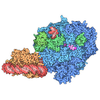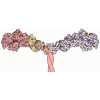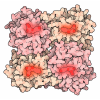+ データを開く
データを開く
- 基本情報
基本情報
| 登録情報 | データベース: PDB / ID: 7tqz | ||||||||||||
|---|---|---|---|---|---|---|---|---|---|---|---|---|---|
| タイトル | Apo CaKip3[2-482] in complex with a microtubule | ||||||||||||
 要素 要素 |
| ||||||||||||
 キーワード キーワード | MOTOR PROTEIN / Kip3 / kinesin / motility / microtubule / tubulin | ||||||||||||
| 機能・相同性 |  機能・相同性情報 機能・相同性情報tubulin-dependent ATPase activity / plus-end specific microtubule depolymerization / regulation of mitotic spindle elongation / mitotic spindle astral microtubule / meiotic sister chromatid segregation / nuclear microtubule / mitotic spindle midzone / nuclear migration along microtubule / microtubule plus-end / microtubule nucleation ...tubulin-dependent ATPase activity / plus-end specific microtubule depolymerization / regulation of mitotic spindle elongation / mitotic spindle astral microtubule / meiotic sister chromatid segregation / nuclear microtubule / mitotic spindle midzone / nuclear migration along microtubule / microtubule plus-end / microtubule nucleation / mitotic spindle disassembly / Microtubule-dependent trafficking of connexons from Golgi to the plasma membrane / Resolution of Sister Chromatid Cohesion / Hedgehog 'off' state / Cilium Assembly / Intraflagellar transport / COPI-dependent Golgi-to-ER retrograde traffic / Mitotic Prometaphase / Carboxyterminal post-translational modifications of tubulin / RHOH GTPase cycle / EML4 and NUDC in mitotic spindle formation / Sealing of the nuclear envelope (NE) by ESCRT-III / Kinesins / PKR-mediated signaling / Separation of Sister Chromatids / The role of GTSE1 in G2/M progression after G2 checkpoint / Aggrephagy / plus-end-directed microtubule motor activity / RHO GTPases activate IQGAPs / RHO GTPases Activate Formins / kinesin complex / HSP90 chaperone cycle for steroid hormone receptors (SHR) in the presence of ligand / microtubule depolymerization / MHC class II antigen presentation / Recruitment of NuMA to mitotic centrosomes / COPI-mediated anterograde transport / microtubule-based movement / negative regulation of microtubule polymerization / establishment of mitotic spindle orientation / mitotic sister chromatid segregation / mitotic spindle assembly / microtubule-based process / mitotic spindle organization / structural constituent of cytoskeleton / microtubule cytoskeleton organization / mitotic cell cycle / microtubule cytoskeleton / microtubule binding / 加水分解酵素; 酸無水物に作用; GTPに作用・細胞または細胞小器官の運動に関与 / microtubule / GTPase activity / GTP binding / ATP hydrolysis activity / ATP binding / metal ion binding / nucleus / cytoplasm 類似検索 - 分子機能 | ||||||||||||
| 生物種 |  Candida albicans (酵母) Candida albicans (酵母) | ||||||||||||
| 手法 | 電子顕微鏡法 / らせん対称体再構成法 / クライオ電子顕微鏡法 / 解像度: 2.7 Å | ||||||||||||
 データ登録者 データ登録者 | Benoit, M.P.M.H. / Asenjo, A.B. / Hunter, B. / Allingham, J.S. / Sosa, H. | ||||||||||||
| 資金援助 |  米国, 米国,  カナダ, 3件 カナダ, 3件
| ||||||||||||
 引用 引用 |  ジャーナル: Nat Commun / 年: 2022 ジャーナル: Nat Commun / 年: 2022タイトル: Kinesin-8-specific loop-2 controls the dual activities of the motor domain according to tubulin protofilament shape. 著者: Byron Hunter / Matthieu P M H Benoit / Ana B Asenjo / Caitlin Doubleday / Daria Trofimova / Corey Frazer / Irsa Shoukat / Hernando Sosa / John S Allingham /   要旨: Kinesin-8s are dual-activity motor proteins that can move processively on microtubules and depolymerize microtubule plus-ends, but their mechanism of combining these distinct activities remains ...Kinesin-8s are dual-activity motor proteins that can move processively on microtubules and depolymerize microtubule plus-ends, but their mechanism of combining these distinct activities remains unclear. We addressed this by obtaining cryo-EM structures (2.6-3.9 Å) of Candida albicans Kip3 in different catalytic states on the microtubule lattice and on a curved microtubule end mimic. We also determined a crystal structure of microtubule-unbound CaKip3-ADP (2.0 Å) and analyzed the biochemical activity of CaKip3 and kinesin-1 mutants. These data reveal that the microtubule depolymerization activity of kinesin-8 originates from conformational changes of its motor core that are amplified by dynamic contacts between its extended loop-2 and tubulin. On curved microtubule ends, loop-1 inserts into preceding motor domains, forming head-to-tail arrays of kinesin-8s that complement loop-2 contacts with curved tubulin and assist depolymerization. On straight tubulin protofilaments in the microtubule lattice, loop-2-tubulin contacts inhibit conformational changes in the motor core, but in the ADP-Pi state these contacts are relaxed, allowing neck-linker docking for motility. We propose that these tubulin shape-induced alternations between pro-microtubule-depolymerization and pro-motility kinesin states, regulated by loop-2, are the key to the dual activity of kinesin-8 motors. | ||||||||||||
| 履歴 |
|
- 構造の表示
構造の表示
| 構造ビューア | 分子:  Molmil Molmil Jmol/JSmol Jmol/JSmol |
|---|
- ダウンロードとリンク
ダウンロードとリンク
- ダウンロード
ダウンロード
| PDBx/mmCIF形式 |  7tqz.cif.gz 7tqz.cif.gz | 257.1 KB | 表示 |  PDBx/mmCIF形式 PDBx/mmCIF形式 |
|---|---|---|---|---|
| PDB形式 |  pdb7tqz.ent.gz pdb7tqz.ent.gz | 199 KB | 表示 |  PDB形式 PDB形式 |
| PDBx/mmJSON形式 |  7tqz.json.gz 7tqz.json.gz | ツリー表示 |  PDBx/mmJSON形式 PDBx/mmJSON形式 | |
| その他 |  その他のダウンロード その他のダウンロード |
-検証レポート
| 文書・要旨 |  7tqz_validation.pdf.gz 7tqz_validation.pdf.gz | 1.7 MB | 表示 |  wwPDB検証レポート wwPDB検証レポート |
|---|---|---|---|---|
| 文書・詳細版 |  7tqz_full_validation.pdf.gz 7tqz_full_validation.pdf.gz | 1.8 MB | 表示 | |
| XML形式データ |  7tqz_validation.xml.gz 7tqz_validation.xml.gz | 53.1 KB | 表示 | |
| CIF形式データ |  7tqz_validation.cif.gz 7tqz_validation.cif.gz | 78.4 KB | 表示 | |
| アーカイブディレクトリ |  https://data.pdbj.org/pub/pdb/validation_reports/tq/7tqz https://data.pdbj.org/pub/pdb/validation_reports/tq/7tqz ftp://data.pdbj.org/pub/pdb/validation_reports/tq/7tqz ftp://data.pdbj.org/pub/pdb/validation_reports/tq/7tqz | HTTPS FTP |
-関連構造データ
| 関連構造データ | 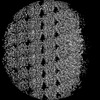 26076MC 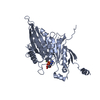 7lffC 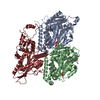 7tqxC 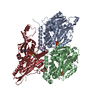 7tqyC  7tr0C  7tr1C  7tr2C  7tr3C M: このデータのモデリングに利用したマップデータ C: 同じ文献を引用 ( |
|---|---|
| 類似構造データ | 類似検索 - 機能・相同性  F&H 検索 F&H 検索 |
- リンク
リンク
- 集合体
集合体
| 登録構造単位 | 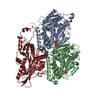
|
|---|---|
| 1 |
|
- 要素
要素
-タンパク質 , 3種, 3分子 ABK
| #1: タンパク質 | 分子量: 50204.445 Da / 分子数: 1 / 由来タイプ: 天然 / 由来: (天然)  |
|---|---|
| #2: タンパク質 | 分子量: 49999.887 Da / 分子数: 1 / 由来タイプ: 天然 / 由来: (天然)  |
| #3: タンパク質 | 分子量: 54869.469 Da / 分子数: 1 / 由来タイプ: 組換発現 / 由来: (組換発現)  Candida albicans (酵母) / 遺伝子: KIP3, orf19.7353, CAALFM_C305720CA / 発現宿主: Candida albicans (酵母) / 遺伝子: KIP3, orf19.7353, CAALFM_C305720CA / 発現宿主:  |
-非ポリマー , 4種, 4分子 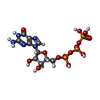

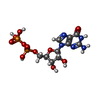
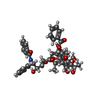



| #4: 化合物 | ChemComp-GTP / |
|---|---|
| #5: 化合物 | ChemComp-MG / |
| #6: 化合物 | ChemComp-GDP / |
| #7: 化合物 | ChemComp-TA1 / |
-詳細
| 研究の焦点であるリガンドがあるか | N |
|---|
-実験情報
-実験
| 実験 | 手法: 電子顕微鏡法 |
|---|---|
| EM実験 | 試料の集合状態: FILAMENT / 3次元再構成法: らせん対称体再構成法 |
- 試料調製
試料調製
| 構成要素 |
| ||||||||||||||||||||||||
|---|---|---|---|---|---|---|---|---|---|---|---|---|---|---|---|---|---|---|---|---|---|---|---|---|---|
| 分子量 | 実験値: NO | ||||||||||||||||||||||||
| 由来(天然) |
| ||||||||||||||||||||||||
| 由来(組換発現) | 生物種:  | ||||||||||||||||||||||||
| 緩衝液 | pH: 6.8 | ||||||||||||||||||||||||
| 緩衝液成分 |
| ||||||||||||||||||||||||
| 試料 | 包埋: NO / シャドウイング: NO / 染色: NO / 凍結: YES | ||||||||||||||||||||||||
| 試料支持 | グリッドの材料: GOLD / グリッドのタイプ: UltrAuFoil R2/2 | ||||||||||||||||||||||||
| 急速凍結 | 装置: FEI VITROBOT MARK IV / 凍結剤: ETHANE |
- 電子顕微鏡撮影
電子顕微鏡撮影
| 実験機器 |  モデル: Titan Krios / 画像提供: FEI Company |
|---|---|
| 顕微鏡 | モデル: FEI TITAN KRIOS |
| 電子銃 | 電子線源:  FIELD EMISSION GUN / 加速電圧: 300 kV / 照射モード: FLOOD BEAM FIELD EMISSION GUN / 加速電圧: 300 kV / 照射モード: FLOOD BEAM |
| 電子レンズ | モード: BRIGHT FIELD / 最大 デフォーカス(公称値): 2480 nm / 最小 デフォーカス(公称値): 690 nm / アライメント法: COMA FREE |
| 試料ホルダ | 凍結剤: NITROGEN 試料ホルダーモデル: FEI TITAN KRIOS AUTOGRID HOLDER |
| 撮影 | 電子線照射量: 71.05 e/Å2 / 検出モード: COUNTING フィルム・検出器のモデル: GATAN K2 SUMMIT (4k x 4k) |
| 画像スキャン | 動画フレーム数/画像: 40 / 利用したフレーム数/画像: 1-40 |
- 解析
解析
| EMソフトウェア |
| |||||||||||||||||||||||||||||||||||||||||||||||||||||||
|---|---|---|---|---|---|---|---|---|---|---|---|---|---|---|---|---|---|---|---|---|---|---|---|---|---|---|---|---|---|---|---|---|---|---|---|---|---|---|---|---|---|---|---|---|---|---|---|---|---|---|---|---|---|---|---|---|
| CTF補正 | タイプ: PHASE FLIPPING AND AMPLITUDE CORRECTION | |||||||||||||||||||||||||||||||||||||||||||||||||||||||
| らせん対称 | 回転角度/サブユニット: 168.087 ° / 軸方向距離/サブユニット: 5.55 Å / らせん対称軸の対称性: C1 | |||||||||||||||||||||||||||||||||||||||||||||||||||||||
| 粒子像の選択 | 詳細: manual picking of filaments | |||||||||||||||||||||||||||||||||||||||||||||||||||||||
| 3次元再構成 | 解像度: 2.7 Å / 解像度の算出法: FSC 0.143 CUT-OFF / 粒子像の数: 162955 詳細: 2 half datasets containing one distinct half of each filament were refined independently. Number of asymmetric units used is reported in "number of segments used", due to the local processing strategy employed. 対称性のタイプ: HELICAL | |||||||||||||||||||||||||||||||||||||||||||||||||||||||
| 原子モデル構築 | プロトコル: FLEXIBLE FIT / 空間: REAL |
 ムービー
ムービー コントローラー
コントローラー









 PDBj
PDBj


